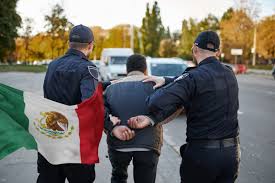Mexico, a country rich in culture, history, and natural beauty, also grapples with the challenge of crime and violence in some of its urban centers. The issue of safety in Mexico is complex, influenced by various socioeconomic factors, drug trafficking, corruption, and organized crime. While many cities in Mexico are safe for residents and tourists alike, some areas experience higher levels of crime, making them among the most dangerous cities in the country. In this exploration, we delve into the factors contributing to the danger in these cities and efforts to address these challenges.
Tijuana:
- Situated along the U.S.-Mexico border, Tijuana is known for its vibrant culture and bustling tourism industry. However, it also grapples with high levels of crime, primarily fueled by drug trafficking and organized crime groups vying for control of lucrative routes into the United States. Violent clashes between rival gangs and incidents of extortion pose significant challenges to the city’s security.
Acapulco:
- Once a glamorous resort town frequented by Hollywood stars, Acapulco has seen a sharp decline in tourism due to escalating violence. Drug cartels compete for control of the city’s drug trade and engage in territorial disputes, resulting in frequent shootings, kidnappings, and extortion. Despite efforts to improve security, including the deployment of federal forces, Acapulco continues to struggle with crime.
Ciudad Juárez:
- Located across the border from El Paso, Texas, Ciudad Juárez gained notoriety for its high murder rate, particularly during the peak of the Mexican Drug War. While violence has decreased in recent years, the city still faces challenges related to drug trafficking and organized crime. Poverty and unemployment exacerbate social tensions, contributing to the city’s reputation as one of Mexico’s most dangerous.
Culiacán:
- As the capital of the state of Sinaloa, Culiacán is known as the birthplace of several prominent drug cartels, including the Sinaloa Cartel led by Joaquín “El Chapo” Guzmán. Despite efforts by authorities to dismantle criminal networks, the city continues to experience violence related to drug trafficking and organized crime. Assassinations, extortion, and public shootouts remain common occurrences.
Veracruz:
- Situated on Mexico’s Gulf Coast, Veracruz faces challenges stemming from its strategic location for drug trafficking and smuggling activities. Corruption within local law enforcement and government institutions has hindered efforts to address crime effectively. The city’s port serves as a key entry point for illicit substances, contributing to its reputation as one of Mexico’s most dangerous cities.
Reynosa:
- Located in the northeastern state of Tamaulipas, Reynosa is a major hub for drug trafficking and human smuggling operations. The city has experienced high levels of violence attributed to clashes between rival criminal groups and confrontations with security forces. Residents face threats of extortion, kidnapping, and targeted violence, creating a climate of fear and insecurity.
Monterrey:
- Once considered one of Mexico’s safest and most prosperous cities, Monterrey has seen a rise in crime in recent years, primarily linked to organized crime and drug trafficking. Extortion and kidnapping for ransom are prevalent, targeting both businesses and wealthy individuals. While efforts have been made to improve security through increased police presence and community engagement, challenges persist.
Chihuahua:
- As the capital of the state of Chihuahua, the city of Chihuahua contends with high levels of violence associated with drug trafficking and organized crime. Cartel activity, along with endemic corruption, poses significant challenges to law enforcement efforts. Despite ongoing efforts to enhance security, including the implementation of crime prevention programs, the city continues to struggle with crime rates above the national average.
Guadalajara:
- Mexico’s second-largest city, Guadalajara, faces security challenges stemming from organized crime groups involved in drug trafficking and extortion. While violence levels are lower compared to some other cities on this list, sporadic incidents of cartel-related violence and street crime occur. The city’s prominence as a commercial and cultural center makes it a target for criminal activity.
Ecatepec:
- Part of the greater Mexico City metropolitan area, Ecatepec suffers from high rates of violent crime, including homicides, robberies, and sexual assaults. Poverty, unemployment, and inadequate policing contribute to the city’s insecurity. Despite government initiatives to improve security and infrastructure, challenges persist, affecting the quality of life for residents.
Efforts to Address Crime:
Addressing the underlying causes of crime in Mexico’s most dangerous cities requires a multifaceted approach, including:
- Strengthening law enforcement and judicial institutions to combat corruption and impunity.
- Investing in social programs aimed at poverty alleviation, education, and youth empowerment.
- Enhancing collaboration between federal, state, and municipal authorities to coordinate security efforts.
- Engaging communities through crime prevention initiatives and fostering trust between residents and law enforcement.
- Targeting the root causes of drug trafficking and organized crime through comprehensive strategies, including drug rehabilitation and alternative economic opportunities.
While the challenges facing Mexico’s most dangerous cities are significant, concerted efforts by government agencies, civil society organizations, and communities can lead to improvements in public safety and security. By addressing the complex interplay of socioeconomic factors and criminal dynamics, Mexico can work towards creating safer and more prosperous urban environments for all its residents.


